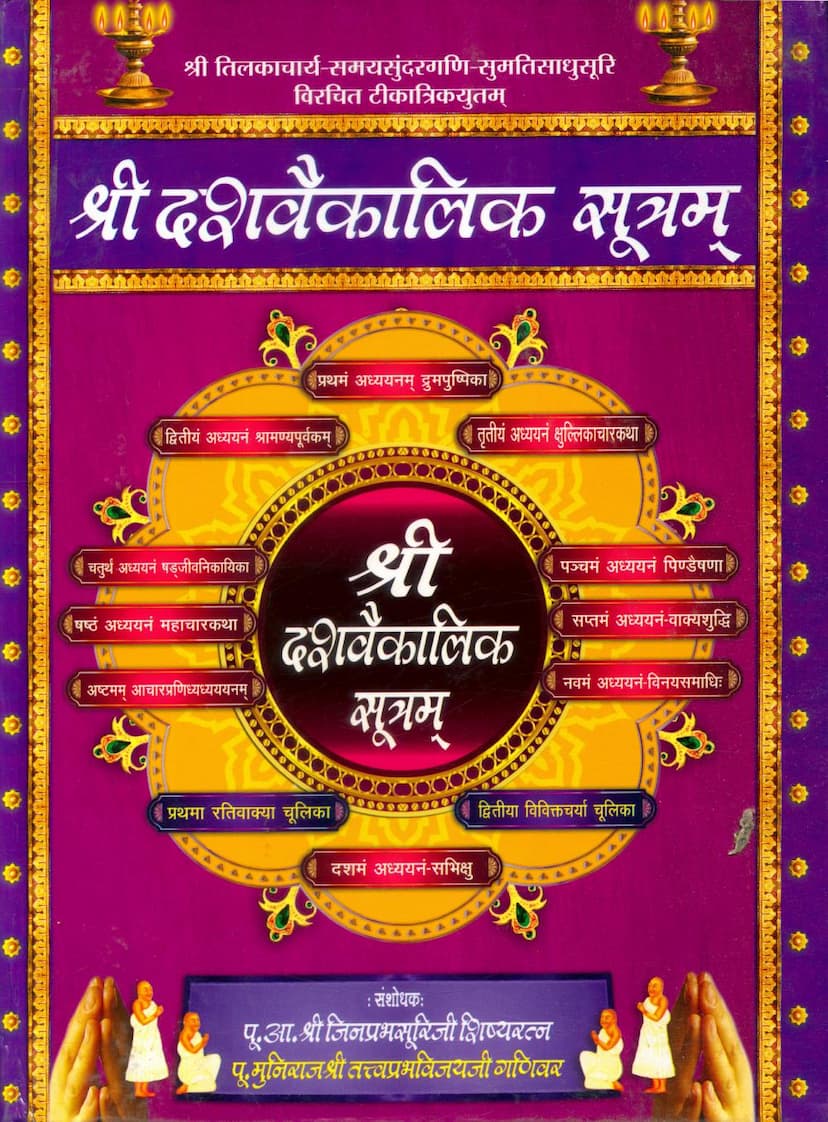Dashvaikalik Sutram
Added to library: September 1, 2025

Summary
This is a comprehensive summary of the Dashvaikalik Sutram based on the provided text, incorporating the content from the pages you've shared.
Dashvaikalik Sutram: A Summary
The Dashvaikalik Sutram, a foundational text in Jainism, is attributed to Shrutakevali Shyayambhav Suri. The provided text is a commentary-rich edition published by Jinprabhsuri Granthmala, with research and editing by Muni Shri Tattvapravvijayji, a disciple of Acharya Shri Jinprabh Suri. The commentary itself is a compilation of three earlier works by Shri Tilakacharya, Shri Samaysundargani, and Shri Sumatisadhusuri.
Core Teachings and Structure:
The Dashvaikalik Sutram is considered a "root mantra" for monastic life, offering profound guidance on essential aspects of ascetism. It emphasizes:
- Austerity (Tapas): The text delves into the importance of various forms of austerity as a means to spiritual purification and liberation.
- Non-violence (Ahimsa): Non-violence towards all living beings, encompassing the six life-forms (ekendriyas to manas-vadis), is a central theme.
- Self-Control (Sanyam): Restraint of the senses and passions is crucial for spiritual progress.
- Right Conduct (Achar): The sutra provides detailed guidelines for the conduct of monks, covering their daily life, interactions, and spiritual practices.
- Purity of Sustenance (Pindeshana): The text offers instructions on the pure and ethical acquisition of food, vital for ascetic practice.
- Speech Purity (Vakya Shuddhi): Emphasis is placed on the correct and pure use of language, avoiding falsehood, harshness, and gossip.
- Patience and Resilience: The text highlights the importance of enduring hardships and equanimity in the face of difficulties.
- Living a Detached Life (Vivikta Charya): Ascetics are encouraged to live a life free from attachment and sensory distractions.
The Ten Chapters (Adhyayanas):
The Dashvaikalik Sutram is structured into ten chapters, each addressing a specific facet of monastic life:
- Drumapushpika: This introductory chapter likely sets the stage with a metaphor or parable.
- Shramanapurvakam: This chapter likely focuses on the preliminary stages or foundational aspects of asceticism.
- Kshullikachar Katha: This chapter is described as a narrative about the conduct of Kshullikas (minor ascetics), offering practical examples.
- Sajivanikayika: This chapter is dedicated to the detailed discussion of the six life-forms, a cornerstone of Jain ethics, and the principles of non-violence in relation to them.
- Pindeshana: This chapter focuses on the pure and ethical acquisition of food, a critical aspect of monastic discipline, often referred to as "mendicancy" or "begging" in a spiritual context.
- Mahachar Katha: This chapter likely presents narratives or stories illustrating the "great conduct" or advanced practices of ascetics.
- Vakyashuddhi: This chapter focuses on the purity of speech, guiding ascetics on how to speak correctly, avoid harmful speech, and use language in a beneficial way.
- Achar Pranidhyadhyayan: This chapter emphasizes the importance of diligence and meticulousness in following the prescribed conduct.
- Vinaya Samadhi: This chapter highlights the virtue of humility and respect towards one's preceptor and elders, and the resulting mental tranquility.
- Sabhikshu: This chapter likely focuses on the ideal qualities and conduct of an ideal monk.
Commentary and Scholarly Apparatus:
The edition you've provided is notable for its extensive commentary, featuring three prominent commentators:
- Shri Tilakacharya: Known for his detailed and poetic explanations.
- Shri Samaysundargani: Contributed a "word-meaning" commentary.
- Shri Sumatisadhusuri: Provided a concise commentary based on Shri Haribhadrasuri's extensive work.
The editor, Muni Shri Tattvapravvijayji, has meticulously collated these commentaries, aiming to make the subtle meanings and the variations in interpretation accessible to a wider audience. The text also includes:
- Prolegomena (Sampadiyam & Prastavikyam): Introductions by the editor and others that shed light on the significance of the text and the methodology of the current edition.
- Varying Interpretations: The commentaries highlight different interpretations of key terms and concepts, demonstrating the depth of scholarly engagement with the text.
- Manuscript References: The editor has consulted and referenced multiple manuscripts (eleven in total, with two being detailed commentaries) to establish the most accurate text and commentary.
- Praise for Spiritual Seekers: The text acknowledges and expresses gratitude to individuals and institutions that supported the publication, highlighting the importance of "knowledge accounts" (gyan khata) in furthering spiritual learning.
Key Themes Highlighted in the Commentaries:
The detailed commentaries offer insights into the practical application of Jain principles:
- Distinguishing between true renunciation and mere outward appearance.
- The importance of meticulous conduct in everyday actions to avoid causing harm (himsa).
- The role of the mind and intention (bhava) in ethical actions.
- The superiority of detachment and contentment over worldly pursuits.
- The necessity of respecting the preceptor (guru) and following their teachings diligently.
- The subtle distinctions in Jain ethics, particularly concerning the interaction with different life-forms and the practice of non-violence.
In essence, the Dashvaikalik Sutram, as presented with these extensive commentaries, serves as a practical guide for Jain ascetics, outlining the principles and practices necessary for spiritual purification, the avoidance of karma, and ultimately, the attainment of liberation. The scholarly effort in compiling and explaining these commentaries underscores the enduring relevance and depth of this ancient Jain scripture.